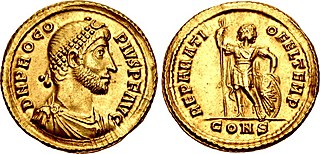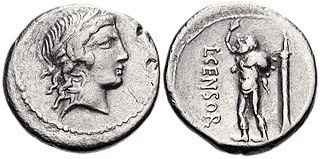The Julian calendar is a solar calendar of 365 days in every year with an additional leap day every fourth year. The Julian calendar is still used in parts of the Eastern Orthodox Church and in parts of Oriental Orthodoxy as well as by the Amazigh people, whereas the Gregorian calendar is used in most parts of the world. It is named after Julius Caesar.

The Roman calendar was the calendar used by the Roman Kingdom and Roman Republic. Although the term is primarily used for Rome's pre-Julian calendars, it is often used inclusively of the Julian calendar established by the reforms of the Dictator Julius Caesar and Emperor Augustus in the late 1st century BC.
Year 8 BC was either a common year starting on Friday or Saturday or a leap year starting on Thursday of the Julian calendar and a common year starting on Wednesday of the Proleptic Julian calendar. At the time, it was known as the Year of the Consulship of Censorinus and Gaius Asinius. The denomination 8 BC for this year has been used since the early medieval period, when the Anno Domini calendar era became the prevalent method in Europe for naming years.
Year 39 BC was either a common year starting on Friday, Saturday or Sunday or a leap year starting on Saturday of the Julian calendar and a common year starting on Saturday of the Proleptic Julian calendar. At the time, it was known as the Year of the Consulship of Censorinus and Sabinus. The denomination 39 BC for this year has been used since the early medieval period, when the Anno Domini calendar era became the prevalent method in Europe for naming years.

Procopius was a Roman usurper against Valens.
Censorinus was a Roman grammarian and miscellaneous writer.

The gens Marcia, occasionally written Martia, was one of the oldest and noblest houses at ancient Rome. They claimed descent from the second and fourth Roman Kings, and the first of the Marcii appearing in the history of the Republic would seem to have been patrician; but all of the families of the Marcii known in the later Republic were plebeian. The first to obtain the consulship was Gaius Marcius Rutilus in 357 BC, only a few years after the passage of the lex Licinia Sextia opened this office to the plebeians.
Proculus was a Roman usurper against Emperor Probus in 280.
The names Sallustius/Saloustios and their vernacular variants Sallust(e) have been borne by many people:

Appius Claudius Censorinus was a fictitious usurper against Roman Emperor Claudius II, according to the unreliable Historia Augusta. He is included in the list of the Thirty Tyrants.
Censorinus was a friend and contemporary of Publius Crassus, son of the triumvir Marcus Crassus. His gens name was almost certainly Marcius, and he may have been the son of the Gaius Marcius Censorinus who was monetalis around 88 BC. If so, his father and uncle Lucius were staunch supporters of the popularist faction of Cinna.

Marcius Censorinus was a name used by a branch of the plebeian gens Marcia of ancient Rome. The cognomen Censorinus was acquired through Gaius Marcius Rutilus, the first plebeian censor, whose son used it. The gens Marcia claimed descent from both Ancus Marcius, a king of Rome, and symbolically from Marsyas the satyr, who was associated with free speech and political liberty; see further discussion at Prophecy and free speech at Rome. The Marcii Censorini were consistent populares, supporting Marius, Cinna, Julius Caesar, and Antonius.
Lucius Marcius Censorinus was a consul of the Roman Republic in 39 BC, during the Second Triumvirate. He and his colleague Gaius Calvisius Sabinus had been the only two senators who tried to defend Julius Caesar when he was assassinated on the Ides of March in 44 BC, and their consulship under the triumvirate was a recognition of their loyalty.
The gens Caelia was a plebeian family at ancient Rome. The nomen Caelius is frequently confounded with Coelius and Caecilius, with some individuals referred to as Caelius in manuscripts, while appearing as Coelius or Coilius on coins. Although the Caelii asserted their great antiquity, none of them attained any of the higher offices of the Roman state until the praetorship of Publius Caelius in 74 BC, and the first of this gens who obtained the consulship was Gaius Caelius Rufus in AD 17. The emperor Balbinus was a descendant of the Caelii.
AD 2 (II) or 2 AD was a common year starting on Sunday or Monday of the Julian calendar and a common year starting on Sunday of the proleptic Julian calendar. In the Roman Empire, it was known as the Year of the Consulship of Vinicius and Varus, named after Roman consuls Publius Vinicius and Alfenus Varus, and less frequently, as year 755 AUC within the Roman Empire. The denomination "AD 2" for this year has been used since the early medieval period, when the Anno Domini calendar era became the prevalent method in Europe for naming years.

Gaius Marcius Censorinus was a Roman Senator who was elected consul in 8 BC.
The Battle of Lake Tunis was a series of engagements of the Third Punic War fought in 149 BC between the Carthaginians and the Roman Republic. Roman consuls Manius Manilius and Lucius Marcius Censorinus, leading separate forces, made several unsuccessful attempts to breach the walls of Carthage. Later, the Carthaginians launched fire ships, which destroyed most of the Roman fleet. Eventually Censorinus returned to Rome, leaving Manilius to continue fighting.
This page is based on this
Wikipedia article Text is available under the
CC BY-SA 4.0 license; additional terms may apply.
Images, videos and audio are available under their respective licenses.





